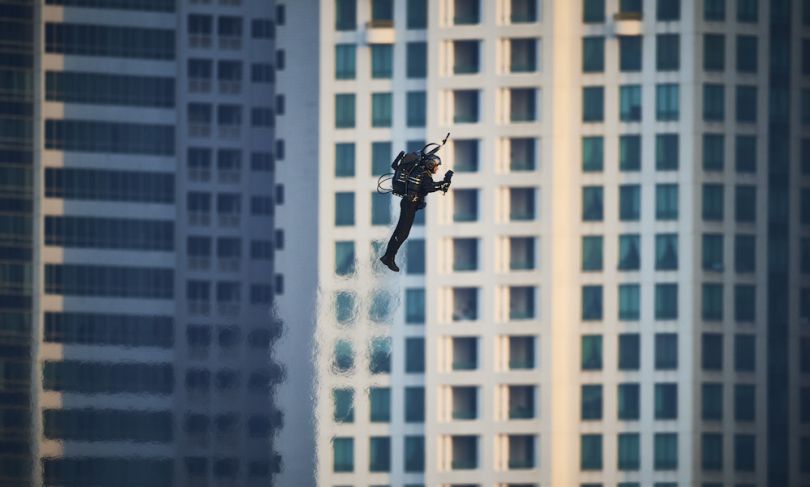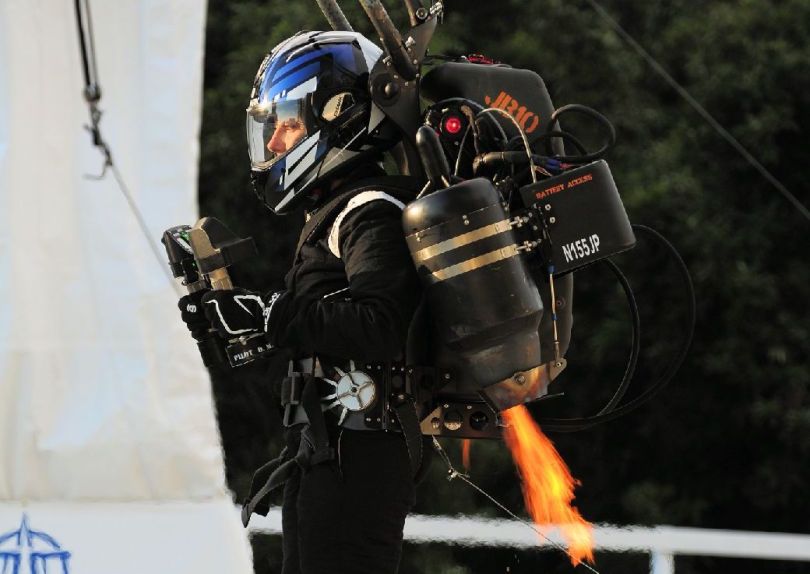The jetpack has gripped the cultural imagination for nearly a century.
The iconic image of an individual-sized aircraft strapped conveniently to one’s back has made enough scintillating cameos throughout the years — in everything from pulp magazines to U.S. Army demonstrations to James Bond movies — that its existence (or ubiquity, even) has evolved in the public consciousness into something of an expectation.
We keep wondering: What’s taking so long, and when will we get to use jetpacks for our morning commutes?
To answer this question, I solicited the help of David Mayman, founder and chief executive of JetPack Aviation, a company that makes jetpacks and flying motorcycles.
Mayman, a seasoned hobbyist pilot, enjoyed a successful career in management consulting and founded various technology companies before he invested millions of his own money in jetpack research and development.
He recruited a team of engineers and developers, and for nearly a decade, he bankrolled false starts and failed test flights. In 2015, though, after eight years of trying, JetPack Aviation officially made a breakthrough — when Mayman successfully piloted a jetpack around the Statue of Liberty.
I asked him how he did it.
More importantly: I asked him when I could do it.

How Jetpacks Work — and Why They’re Still Frustratingly Limited
JetPack Aviation’s most basic offering, the JB-10 jetpack, uses two turbojet engines, which are slightly different than the ones you see on an airliner. They have something called zero-bypass ratios, which means all of the air that comes into the front of the engine is being used by the combustion system to produce thrust.
“It’s not the most fuel-efficient form of propulsion,” Mayman told me, “but it produces an extraordinary amount of power for the size and weight of the engine, which is obviously what you’re looking for if you’re talking about strapping something on your back.”
Each of the engines has a fuel pump and an engine computer. To take off, the pilot increases engine thrust using a switch on the right-side handle. The handle’s computer translates this mechanical signal into a digital one and tells a master computer, which then sends that information to the individual engine computers, ordering it to keep the thrust balanced on each side. (Think Tony Stark’s Iron Man suit helping him stay level.)
Done correctly, this setup will propel the pilot into the air in a stabilized, upright position for up to eight minutes. Speeds top out at 120 miles per hour. It looks extremely badass.
The toughest tech challenge, Mayman said, was balancing the thrust from the engine so the jetpack could maintain control. Even the slightest bit of lopsidedness could send the jetpack veering. To account for this, Mayman’s crew had to build a computer system that would accurately and quickly balance the thrust across the engines.

What’s Been Taking So Long?
“It’s no longer an issue of the stabilization systems, it’s not the software system, it’s not the code,” Mayman said of the holdup to getting jetpacks into the mainstream. “It comes down to the propulsion technology.”
He’s referring to the less-than-ideal circumstances that govern the power source that pushes jetpacks in the air. Electric power would be nice, but, so far, it hasn’t been feasible, Mayman said, because batteries can’t hold enough energy.
“It’s no longer an issue of the stabilization systems, it’s not the software system, it’s not the code.”
“It comes down to having fuel with greater energy density than kerosene or diesel, which is really tough,” he said. “Introducing a more efficient turbine engine is what will do it. But there’s probably a couple of hundred million dollars worth of research [required].”
Mayman is confident engineers will overcome this challenge within the next few years. At that point, he believes, electric propulsion may be possible.
“I do see the energy density of batteries improving. It’s not improving extraordinarily quickly, but it is improving. And once we see a sort of a step change in the battery chemistry, then maybe we get the kind of [power] we need rather than [what] we’re stuck with at the moment.”
There’s another reason too. More efficient power requires more money. Historically, the companies that specialize in building these sorts of engines have had little financial incentive to speed up the capabilities of engines that small.
Lately, though, that’s changed. There’s been an uptick in commercial and military investments in drone engine technology. And jetpacks, it is believed, can piggyback off the advancements being made there.

When Will I Get to Commute With a Jetpack?
Flying a jetpack in a controlled test facility outside of Los Angeles is cool. You know what’s cooler? Flying one from my apartment to the office.
So I asked Mayman when it’s reasonable for me to expect everyday commuters to be zipping around wearing one of his jetpacks.
“I can’t say whether that will be in the next two to three years or five years,” he said. “But it definitely will be something that the average member of the public will be able to operate at some point.”
“I think that ultimate freedom of being able to step outside of your house, throw on a jetpack and fly away is something that many people are fascinated with.”
Mayman said his company’s jetpacks are registered in two categories in the United States with the Federal Aviation Administration. One is the “ultralight” category, which means I don’t need a pilot license to use my jetpack (nice), but get saddled with heavy restrictions, like no flying in public spaces or cruising too fast (boo). The second category is an experimental certification, meaning as long as I’m a licensed pilot (hmm) I am free to fly around in a jetpack over a broad range of designated air spaces(!).
I asked Mayman what is it that gets us — him — me — so excited about personal flight.
“I think that ultimate freedom of being able to step outside of your house, throw on a jetpack and fly away is something that many people are fascinated with.”




